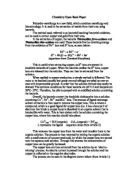Overall, the bacteria convert the insoluble chalcopyrite into a solution containing Cu2+, Fe2+, Fe3+ and SO42- ions. The process of ligand exchange solvent extraction is then used to remove the copper ions. This is where a compound, which is a good ligand for copper ions (i.e. it has a lone pair of electrons that binds to copper ions) is dissolved in an organic solvent that is immiscible with water. This is then shaken with the solution containing the copper ions, where this reaction should take place:
Cu2+(aq) + 2LH (organic) CuL2 (organic) + 2H+(aq)
L represents the ligand (equation taken from Article 2)
This removes the copper ions from the water and transfers them to the organic solution. The process is then reversed by mixing the organic solution with a small amount of concentrated acid, by which the copper ions are moved onto the aqueous acid solution. Through this process the concentration of copper ions can be greatly increased.
The copper ions are then extracted from the solution by an ‘electro-winning’ process. An electric current is passed through the solution and the copper is collected on the negative electrodes.
The process can be seen in the diagram shown below (from Article 1):
The bacterial leaching process has proved better than the original method of smelting the ores in many ways. Smelting 1 tonne of copper ore produces 2 tonnes of sulphur dioxide. Bacterial leaching does not form any polluting waste. This is not only beneficial to the environment, but it also means that firms will not have to pay due to restrictions on sulphur dioxide emissions. It is also a much cheaper process. Biohydro-metallurgy costs less than £70 per tonne, whereas smelting copper ore costs £130-£200 per tonne. Also, biohydro-metallurgy enables even low-grade ore and tailings to be used, and therefore cuts down on this polluting factor. It also provides a method of underground mining, without environmental damage.
Unfortunately this process is extremely slow and therefore is not profitable. As Keith Debus said, ‘…biological approaches have often been found to be cheaper, but delay in each flow from slower production had hindered adoption.’- (Article 1). This is why it is the secondary extraction process for copper.
The extraction of gold is performed through the oxidation of the gold ore, e.g. arsenopyrite.
First the froth floatation stage occurs, through which the refractory minerals are separated from any unwanted substances, e.g. non-metallic minerals.
Next is the bacterial oxidation stage. The refractory sulphide concentrate, produced by the floatation stage, is treated with a mixed culture of moderately thermophilic bacteria at 46°C, in solution with pH 0.5-1.5.
There are two stages to this. First the bacteria catalyse the formation of iron(II), arsenic(III) and sulphur(VI), which are soluble compounds, from e.g. arsenopyrite:
FeAsS ⎯⎯→ Fe(II) + As(III) + S(VI)
Then iron(II) and arsenic(III) are oxidised:
Fe(II) ⎯⎯→ Fe(III)
As(III) ⎯⎯→ As(V) (equations taken from Article 3- Box 1)
Now is the cyanidation stage. The resulting mixture is treated with an aerated solution of sodium cyanide, by which the gold is extracted.
This method is preferred to the traditional method for many reasons. The previous method recovered 10% of the gold, whereas this method recovers 100% of the gold- as seen in the graph below (from Article 3):
Also, the traditional method produced sulphur dioxide and arsenic(III) oxide, both of which are polluting and have unwanted economic implications. However this method produces no gases and the waste water produced can be treated to remove the impurities as precipitates and can be neutralised by crushed limestone. There is the possibility that acid rain or river water may react with the waste water and dissolve the arsenic(V). However, ‘the highest concentration of arsenic in such waters does not reach the US Environmental Protection Agency limit of 2 ppm’- (Article3, Box1) and can therefore be seen as safe.
The factor most in favour of the new method is the fact that the cost of running the plant is roughly only $30 per tonne of concentrate. This includes power, chemicals, maintenance and labour. Here is where a problem may arise. Only one person is needed per shift. This means that many people will lose jobs.
Another advantage of the bacterial method is that other base metals are recovered during gold extraction. This alone ‘is feasible and economically competitive with conventional process’- (Article3)








